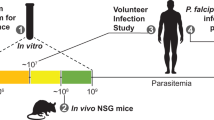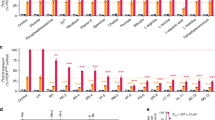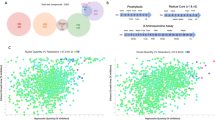Abstract
THE demonstration that the mechanism of pigment formation in the rodent malaria parasite, Plasmodium berghei, could be disturbed when the parasites became resistant to the antimalarial drug, chloroquine1,2, has since been confirmed by Thompson et al.3. The same phenomenon has now been described by Jacobs in a quinine-resistant strain4. In continuation of our own investigations we have developed two further strains of P. berghei, one of which, the P strain, has a high level of primary resistance to the 8-aminoquinoline compound, primaquine, and the second, the M strain, a high level of primary resistance to the familiar 9-aminoacridine derivative, mepacrine. The methods followed for the induction of drug-resistance in these strains and their subsequent testing for sensitivity to various drugs are identical to those used with the chloroquine-resistant (RC) strain and have been described elsewhere5. Preliminary examination of the ultrastructure of parasites of the P and M strains has been made in association with Dr. W. Stäubli, following the techniques already published2.
This is a preview of subscription content, access via your institution
Access options
Subscribe to this journal
Receive 51 print issues and online access
$199.00 per year
only $3.90 per issue
Buy this article
- Purchase on Springer Link
- Instant access to full article PDF
Prices may be subject to local taxes which are calculated during checkout
Similar content being viewed by others
References
Peters, W., Nature, 203, 1290 (1964).
Peters, W., Fletcher, K. A., and Stäubli, W., Ann. Trop. Med. and Parasit., 59, 126 (1965).
Thompson, P. E., Bayles, A., Olszewski, B., and Waitz, J. A., Science, 148, 1240 (1965).
Jacobs, R. L., J. Parasit., 51, 481 (1965).
Peters, W., Exp. Parasit., 17, 80 (1965).
Peters, W., Exp. Parasit., 17, 90 (1965).
Schueler, F. W., and Cantrell, W. F., J. Pharmacol. Exp. Therap., 143, 278 (1964).
Cohen, S. N., Phifer, K. O., and Yielding, K. L., Nature, 202, 805 (1964).
Deegan, T., and Maegraith, B. G., Ann. Trop. Med. and Parasit., 50, 194 (1956).
Sherman, I. W., Mudd, J. B., and Trager, W. (preceding communication).
Ball, E. G., McKee, R. W., Anfinsen, C. B., Cruz, W. O., and Geiman, Q. M., J. Biol. Chem., 175, 547 (1948).
Author information
Authors and Affiliations
Rights and permissions
About this article
Cite this article
PETERS, W. Mepacrine- and Primaquine-resistant Strains of Plasmodium berghei, Vincke and Lips, 1948. Nature 208, 693–694 (1965). https://doi.org/10.1038/208693a0
Issue Date:
DOI: https://doi.org/10.1038/208693a0
This article is cited by
Comments
By submitting a comment you agree to abide by our Terms and Community Guidelines. If you find something abusive or that does not comply with our terms or guidelines please flag it as inappropriate.



